
In Photos: Life Up in the Clouds
Forests in the clouds
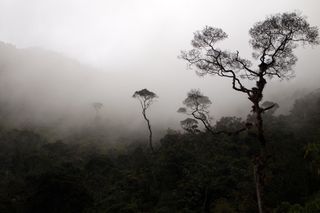
Pregnant with secrets and dripping with wonder, cloud forests exude mystery and magic to those who venture into their depths. Gnarled limbs festooned with mosses drip moisture, small birds flit through the understory, and colorful orchids glow through the misty air high above in the canopy.
Cloud forests are characterized by tropical or subtropical montane forests occuring at higher elevations in tropical climates. They are also sometimes called fog forests for their abundant fog and canopy-level cloud cover. Tropical cloud forests extend between 23 degrees north latitude to 25 degrees south latitude at elevations between 5,000 to 10,000 feet (1,500 and 3,000 meters) above sea level on continental landmasses. They often occur at much lower elevations as low as 1,600 feet (500 m) on oceanic islands, such as in the Caribbean and Hawaii.
Storehouses for biodiversity, providers of abundant fresh water, and home to thousands of indigenous cultures the world over, tropical cloud forests are biological wonders of the world.
Diversity of life
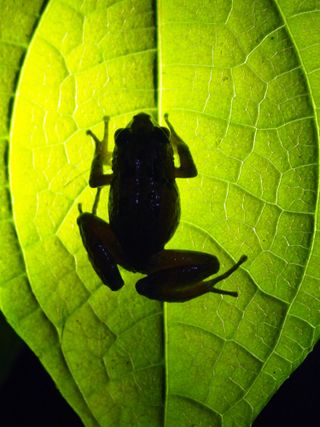
In the cloud forests abutting the eastern edge of the tropical Andes in countries like Peru, Ecuador and Colombia is found some of the richest biodiversity on planet Earth. This narrow band of habitat between the mountains and the jungle, or "la ceja de la selva" (the eyebrow of the jungle), is recognized by scientists as one of the world's mega-biodiversity hotspots.
Warm, moist conditions and almost vertical topography enable high numbers of different species to thrive in these forests. Despite the rich numbers of species found though, it is estimated that only about 80 percent of cloud forest species have been catalouged by scientists.
With so little still known about these unusually rich ecosystems, we are now in danger of losing them before they have even begun to be understood. This photo is of a rare frog, Pristimantis canari, found only in a few isolated cloud forests in Ecuador's eastern Andes.
Stranger than fiction
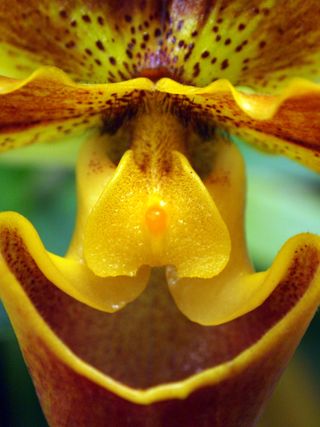
No, this is not a goofy clown face, it's an orchid. As elaborate and strange as this may seem, unusual evolutionary forms are not at all out-of-the ordinary for the orchid world. In fact, as is often the case, the science is stranger than fiction.
With between 30,000 and 50,000 species of orchids known to science, they are some of the most biodiverse species found in cloud forests. Here in the cool, moisture-laden air they thrive best and reach their showiest expression.
Orchids are seducers of the plant world, seducing their pollinators, willingly or not, to spread their pollen, sometimes over great distances. Some mimic the chemical cues and pheremones of their insect pollinators. Others attract with color and scent only to trap their pollinators in their flowery folds long enough to smear them with pollen. Still others mimic the very appearance of insects with tiny hairs and elaborately evolved parts looking uncannily like a fly, bee or wasp.
Endemic species

This photo is of the bamboo rain peeper (Pristimantis bambuscara), a new species my students and I helped field biologists discover in 2010 in the cloud forests of Ecuador's eastern Andes. As far as is known, this species is endemic to only this area and found nowhere else.
In fact, new species are routinely discovered in cloud forests. One of the most famous cases in history was that of the golden toad (Bufo periglenes), a new species discovered in a tiny section of Costa Rica's Monteverede Cloud Forest Reserve in the 1960s. With bright golden skin, the males of the species were like nothing anyone had ever seen before. Despite the buzz of the new discovery, by 1989 the golden toad's tiny population had disappeared, never to be seen again.
The golden toad is a case study of the dangers endemic populations face. With such small populations, it takes only one catastrophe to wipe out an entire species.
Cycles succession
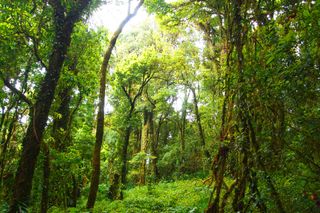
Situated at high altitudes, cloud forests often have to withstand strong winds and intense ultraviolet light. Many trees cave in and fall, letting sunlight flood the forest floor. Waiting patiently there, sometimes for decades, are seeds seeds from forest giants, as well as innumerable vines, flowers and non-woody plants. Thus begins the natural cycle of forest succession.
A race to the sun ensues: Initially, fast-growing but short-lived species propel themselves ever upward to take full advantage of the sun's unharnessed energy. Over time, as the soil becomes shaded and moist again, the rapidly growing woody plants will once again take over. Slowly, the original trees will recolonize, until the repair process is done, leaving little evidence of scarring.
Habitat loss by natural treefall gaps like this one on the slopes of Doi Suthep Mountain in Thailand are important in promoting biodiversity at a local level by allowing species to colonize new patches of habitat.
Habitat fragmentation
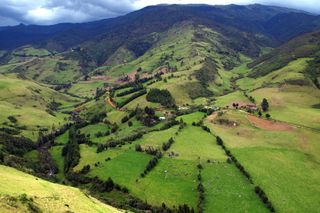
As I helped Don Jose clear brush along the forest edge for a shepard's shed on the border of his land, it dawned on me that this was ground zero for human-induced habitat loss. Habitat loss is seldom big tracts of land swept bare on statistical reports, but rather is forest whittled away in small increments by poor people seeking to simply better their lives and broaden their pastures.
Land conversion for agriculture or pasture, such as this in Ecuador, is the number one threat to cloud forests world wide. Often portrayed as a simple, black-and-white issue, on the ground, tackling habitat loss like this is greyer and difficult to reconcile with local human needs.
As forests are encroached upon for human use, habitat for wildlife is lost. Furthermore, patchier, more fragmented forests surrounded by humans are harder for species to migrate across and degrades the ability of the ecosystem to buffer itself against threats like climage change.
Breakfast of biodiversity
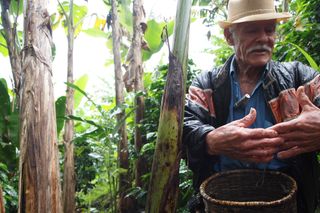
Low-growing herbs and flowers planted as natural insecticides reach up to a dense green layer of arabica coffee bushes blanketing the hillsides. Banana fronds poke above the bushes like bristly hairs, shaded in turn by the branches of dense avocado and fruit trees dancing to the movement of small birds in their boughs.
Walking through this shaded organic coffee farm in Colombia's zone cafeteria, or coffee belt, I'm amazed how much it feels like a forest. The farmer tells me with a proud grin that his farm is not just a farm though, it is a "jardin" a garden.
Planted structurally similar to a forest with natural shade and composed of a diversity of crops and fruit trees growing together organically, this traditional farm both produces food and serves as a refuge for biodiversity. This integration of agriculture with conservation is one ingenious solution in stemming off species extinction in tropical cloud forests worldwide.
Sign up for the Live Science daily newsletter now
Get the world’s most fascinating discoveries delivered straight to your inbox.
For the birds
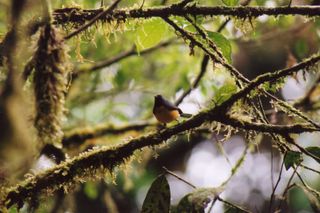
The thrushes and warblers that trapeze through the oak and maple forests of North America in the summer migrate south to spend their winters in tropical forest habitats in Central America, the Caribbean and Colombia. The fate of these birds is tied up globally across continents.
Migratory species like this slate-throated redstart (Myioborus miniatus) in Costa Rica find sanctuary in traditional coffee farms that mimic natural processes and remain shaded. In fact, biologists at the Smithsonian Migratory Bird Center found that traditionally managed coffee and cacao (chocolate) farms support over 150 species of birds. These numbers are only exceeded in undisturbed tropical forests and some species even prefer traditional coffee habitats.
Consumers willing to pay slightly more for bird-friendly and shade coffee have the opportunity to influence land use and conservation that may help conserve not just the birds in their backyard, but countless other tropical and cloud forest species as well.
"Water is life ... care for it!!"
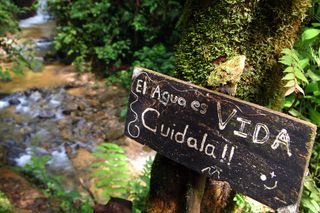
Water is one of the most defining and noticable features to any visiter to the cloud forest. At higher elevations you may literally walk through forest trails draped in cloud mist. With so much air-borne moisture available, mosses and ephiphytes or, "air plants," droop down everywhere to capture it, while mountain streams collect and filter this water into rivers spilling out of the mountains and into the lowlands.
By stripping water from windblown fog, cloud forests provide a crucial hydrologic function. Without cloud forest trees, much of this moisture would never otherwise fall to the ground. This extra water amounts to about 20 percent of ordinary rainfall, providing a huge boon to life downstream, including humans.
Water collected from cloud forests provides a consistent water supply to major rivers important for water consumption, irrigation and hydrolectric power for many people and governments. The environmental and economic benefits of these "ecosystem services" alone are reason enough to conserve cloud forests.
Disappearing in the mist
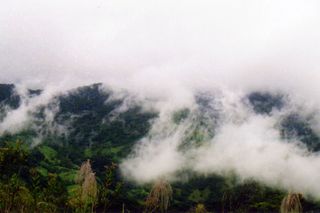
Cloud forests are highly sensitive to climate change because of their dependence on cloud moisture from weather and their geography on slopes. As Earth's climate changes, it is expected that cloud forest habitat will increase with altitude, forcing many species to shift their ranges upslope if they can.
As temperatures increase and weather patterns change, it is also likely that cloud forests stand more risk of drying out and being stressed by increasing extreme weather events like hurricanes. Some biologists worry that if nothing is done to save these forests, we may have only a couple decades left before they are gone.
As fresh storm clouds envelop the hills below in a misty cloak, I bundle on a jacket from my ridgetop perch in the San Luis valley in Costa Rica. During the rainy season I used to come here to watch the clouds roll in like clockwork every afternoon, obscuring the forests below in a beautiful dance. It is my favorite disappearing act. But I wonder, when the mist clears will the cloud forests still remain?












